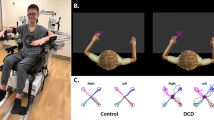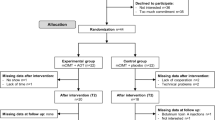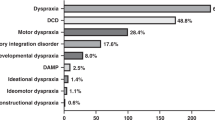Abstract
Objectives
To compare motor skills in patients with infantile strabismus and age and sex-matched control subjects aged 5–11 years.
Methods
Motor performances were assessed by the Italian version of Developmental Coordination Disorder Questionnaire 2007 (DCDQ) in children with infantile strabismus and age and sex-matched control subjects. Patients affected by specific neurological, cognitive and behavioural disorders were excluded from the study.
Results
There were 43 patients included in the study, 23 in the strabismus group (14 males, 9 females, mean age 7.5 ± 2.0 years) and 24 in the control group (14 males and 10 females, mean age 7.2 ± 1.7 years. The overall DCDQ score was significantly lower in children with strabismus compared with control subjects (58.7 ± 11.3 vs. 74.2 ± 1.5; P < 0.001). Children with strabismus and no stereopsis showed a lower DCDQ score compared with those with normal stereopsis (50.8 ± 9.5 vs. 67.3 ± 4.8; P < 0.001).
Conclusion
Motor skills are reduced in children with strabismus compared with control subjects. Strabismus and lack of binocular vision are factors potentially contributing to developmental coordination disorder.
Similar content being viewed by others
Introduction
Strabismus is one of the most common visual development disorders in childhood, with a reported prevalence of approximately 4% [1]. When strabismus occurs during the critical period of normal maturation of the visual system, it can cause amblyopia, which represent the most common cause of low visual acuity in children [2]. In addition, when the images from the two eyes are significantly different, sensory fusion is impossible and a suppression scotoma develops to avoid diplopia. This compromises the ability to discriminate disparity and depth information with loss of stereopsis. Therefore, strabismus may affect normal binocular vision function even in the absence of amblyopia.
Binocular vision provides important sensory input that is essential in the planning and execution of precision tasks. The absence of normal binocularity compromises hand–eye coordination and affects motor performance in terms of movement speed, accuracy, and success in task [3]. An impaired motor coordination may affect all kinds of motor skills, including activities of daily living, which are essential for children’s daily functioning [4].
The purpose of this study was to compare motor skills in patients with infantile strabismus and age and sex-matched control subjects aged 5–11 years.
Methods
This was a prospective, parallel group study. All participants gave their informed consent and the study followed the principles of the Declaration of Helsinki. The study involved children between 5 and 11 years old of age who required strabismus evaluation at the paediatric ophthalmology service. All healthy volunteers attending the clinic were considered eligible for the study. Exclusion criteria were any specific neurological, cognitive and behavioural disorder.
All patients underwent a full ophthalmological assessment. Stereopsis was assessed using the Lang 1 stereotest. All parents of children involved in the study were provided with the Italian version of Developmental Coordination Disorder Questionnaire (DCDQ) 2007 to be completed. The DCDQ is a 15-item parental questionnaire designed to evaluate motor skills and risk of developmental coordination disorder (DCD) in children aged 5–15 years. The questionnaire comprises three subscales: control during movement (items 1–6), fine motor/handwriting (items 7–10), and general coordination (items 11–15). Parents are asked to provide their responses on a five-point Likert scale. Each item is scored from 1 to 5 points, giving a total score of from 15 to 75 points. The cutoff scores indicating the suspect of DCD is <47 for children aged 5–7 years, <56 for those aged 8–9, and <58 for those aged 10–15 [5, 6].
Statistical analysis
The SPSS statistical software (SPSS Inc, Chicago, Illinois, USA) was used for statistical analysis. Values are expressed as mean ± standard deviation. The Student’s t test was used to compare continuous variables between children with strabismus and control subjects and between children with and without stereopsis. The χ2 test was used to compare dichotomous variables. A P value < 0.05 was considered statistically significant.
Results
Twenty-three consecutive children with strabismus and 24 healthy children were enrolled in the study. Mean age was 7.5 ± 2.0 years in children with strabismus and 7.2 ± 1.7 years in the control group (P = 0.621). The gender distribution did not differ significantly between the two groups (14 males and 9 females in the strabismus group, 14 males and 10 females in the control group, P = 0.859). The mean refractive error was +2.4 ± 1.6 D in the strabismus groups and +0.9 ± 1.1 D in the control group (P = 0.001).
Stereopsis was normal in 11 children with strabismus (47.8%) and absent in 12 (52.2%). The strabismus was congenital in all the children with absent stereopsis and acquired in all those with normal stereopsis. Nine children with strabismus (39.1%) had amblyopia, and 14 of them (60.1%) had previously undergone strabismus surgery. None of the children in the control group had either abnormal stereopsis or amblyopia.
The mean motor performances by DCDQ in children with strabismus and control subjects are reported in Table 1. The overall DCDQ score was significantly lower in children with strabismus compared to control subjects (P < 0.001). In particular, children with strabismus showed a lower score in all the three subscales relative to control during movements (P < 0.001), fine motor/handwriting (P < 0.001) and general coordination (P = 0.002). Six patients in the strabismus group (26.1%) and no one in the control group was suspect for DCD.
The mean motor performances by DCDQ in children with strabismus with and without stereopsis are reported in Table 2. The overall DCDQ score was significantly lower in children with absent stereopsis (P < 0.001). In particular, children with absent stereopsis showed a lower score in the subscales relative to control during movements (P < 0.001), and general coordination (P = 0.011), but not on the subscale of fine motor/handwriting (P = 0.305). All the six patients with suspected DCD had absent stereopsis.
The mean motor performances by DCDQ in children with strabismus with and without amblyopia are reported in Table 3. There were no significant differences in overall DCDQ score and in the three subscales between children with and without amblyopia (all P > 0.05). Similarly, motor performances by DCDQ showed no correlation with refractive error (all P > 0.05).
Discussion
Binocular vision offers a number of different advantages over monocular vision, most notably the subjective sensation of three-dimensional visual space and perception of depth. This phenomenon results from the integration of the two slightly dissimilar retinal images (i.e. binocular disparity) and provides important sensory information for motor coordination. Binocular vision is essential for planning and executing movements of the upper limb including reaching, grasping and manipulation of objects [7, 8]. Previous studies have demonstrated that people lacking stereopsis are impaired on different manual tasks [9,10,11,12].
DCD is a condition characterized by a level of performance in skills requiring motor coordination substantially below that expected for age and cognitive abilities [13]. In the present study, we evaluated motor skills in patients with infantile strabismus and age and sex-matched control subjects using the DCDQ. The questionnaire evaluates through parents’ opinions different activities requiring visual-motor integration such as running, jumping, writing, drawing and small object manipulation. Children with strabismus showed significantly lower motor performances compared with control subjects. The reduced motor skills affected all the three subscales of the questionnaire (i.e. control during movements, fine motor/handwriting and general coordination).
Children with congenital strabismus and absent stereopsis demonstrated lower motor skills compared with those with acquired strabismus and normal stereopsis. This confirms the importance of binocular vision for the development of normal motor skills. Interestingly, children without stereopsis were more impaired in the subscale of control during movements, which comprises questions relative to ball games and jumping obstacles. These activities require a high load of 3D information processing and movement into all dimensions of space. Conversely, children with and without stereopsis showed no differences in fine motor skills such as drawing and writing, which are carried out on a single plane and require less processing of 3D information. This result suggests that other factors besides stereopsis may contribute to the lower fine motor skills of children with strabismus. However, we were not able to identify any relationship between motor skills and amblyopia or refractive error.
Our findings are in agreement with a previous study that reported decreased motor skills in children with congenital esotropia using the Movement Assessment Battery for Children [14]. Children with strabismus showed the greatest impairment in the subscale assessing manual dexterity. Interestingly, the surgical correction of strabismus improved the motor function, while no change in stereopsis was detected [14]. This suggests that even in absence of stereopsis, a partial recovery of binocular cooperation secondary to eye realignment may have a positive influence on hand–eye coordination skills.
In the present study, 26.1% of children with strabismus and 50% of those without stereopsis were at risk for DCD. This percentage is higher than the prevalence of DCD in school-aged children, which is ~5–6% [15]. To our knowledge, this is the first study identifying strabismus and lack of binocular vision as factors potentially contributing to DCD. The association has relevant clinical implications because poor motor functioning may limit physical activities and have a significant impact on social relations and educational achievement [16, 17]. Furthermore, the consequences of DCD may be long lasting, and include psychological problems and anxiety in adolescence [18], as well as psychiatric disorders in adulthood [19]. Therefore, poor motor performance in children with strabismus should be early identified to provide specific interventions. In addition, children with DCD should be examined by a paediatric ophthalmologist, since there are form of small-angle strabismus with abnormal binocular vision (i.e. microtropia) that may remain unnoticed without proper screening [20].
One major limitation of the present study is the small number of participants. In addition, motor skills were evaluated with DCDQ, which is based on parental reports rather than on actual motor tasks performed by the child. However, the value of parents in detecting developmental problems about their child’s performance has been demonstrated [21], and DCDQ is considered a valid screening tool for DCD [5, 6].
In conclusion, this study confirms the high incidence of impaired motor function in children with strabismus. Abnormal binocular vision may be one of the factors contributing to DCD. The DCDQ is a useful tool to evaluate the motor function in children with strabismus, which should be considered at risk for DCD. Moreover, children with DCD should be screened for abnormal binocular vision.
Summary
What was known before
-
Binocular vision provides essential sensory information for motor coordination.
-
Children with abnormal binocularity are impaired on different manual tasks.
What this study adds
-
Strabismus and lack of binocular vision are factors potentially contributing to DCD.
References
Donnelly UM, Stewart NM, Hollinger M. Prevalence and outcomes of childhood visual disorders. Ophthalmic Epidemiol. 2005;12:243–50.
Wong AM. New concepts concerning the neural mechanisms of amblyopia and their clinical implications. Can J Ophthalmol. 2012;47:399–409.
Gonzalez DA, Niechwiej-Szwedo E. The effects of monocular viewing on hand–eye coordination during sequential grasping and placing movements. Vis Res. 2016;128:30–8.
Van der Linde BW, van Netten JJ, Otten B, Postema K, Geuze RH, Schoemaker MM. Activities of daily living in children with developmental coordination disorder: performance, learning, and participation. Phys Ther. 2015;95:1496–506.
Wilson BN, Crawford SG, Green D, Roberts G, Aylott A, Kaplan BJ. Psychometric properties of the revised developmental coordination disorder questionnaire. Phys Occup Ther Pediatr. 2009;29:182–202.
Caravale B, Baldi S, Gasparini C, Wilson BN. Cross-cultural adaptation, reliability and predictive validity of the Italian version of Developmental Coordination Disorder Questionnaire (DCDQ). Eur J Paediatr Neurol. 2014;18:267–72.
Jones RK, Lee DN. Why two eyes are better than one: the two views on binocular vision. J Exp Psychol. 1981;7:30–40.
Joy S, Davis H, Buckley D. Is stereopsis linked to hand–eye coordination? Br Orthopt J. 2001;58:38–41.
Grant S, Melmoth DR, Morgan MJ, Finlay AL. Prehension deficits in amblyopia. Investig Ophthalmol Vis Sci. 2007;48:1139–48.
Webber AL, Wood JM, Gole GA, Brown B. The effect of amblyopia of fine motor skills in children. Investig Ophthalmol Vis Sci. 2008;49:594–603.
O’Connor AR, Birch EE, Anderson S, Draper H. The functional significance of stereopsis. Investig Ophthalmol Vis Sci. 2010;51:2019–23.
Suttle CM, Melmoth DR, Finlay AL, Sloper JJ, Grant S. Eye-hand coordination skills in children with and without amblyopia. Investig Ophthalmol Vis Sci. 2011;52:1851–64.
American Psychiatric Association: Diagnostic and Statistical Manual of Mental Disorders. 5th ed. Arlington: American Psychiatric Association; 2013.
Caputo R, Tinelli F, Bancale A, Campa L, Frosini R, Guzzetta A, et al. Motor coordination in children with congenital strabismus: effects of late surgery. Eur J Paediatr Neurol. 2007;11:285–91.
Blank R, Smits-Engelsman B, Polatajko H, Wilson P. European Academy for Childhood Disability. European Academy for Childhood Disability. European Academy for Childhood Disability (EACD): recommendations on the definition, diagnosis and intervention of developmental coordination disorder (long version). Dev Med Child Neurol. 2012;54:54–93.
Lingam R, Golding J, Jongmans MJ, Hunt LP, Ellis M, Emond A. The association between developmental coordination disorder and other developmental traits. Pediatrics. 2010;126:e1109–18.
Harrowell I, Hollen L, Lingam R, Emond A. The impact of developmental coordination disorder on educational achievement in secondary school. Res Dev Disabil. 2018;72:13–22.
Rigoli D, Piek JP, Kane R. Motor coordination and psychosocial correlates in a normative adolescent sample. Pediatrics. 2012;129:e892–900.
Kirby A, Williams N, Thomas M, Hill E. Self-reported mood, general heath, wellbeing and employment status in adults with suspected DCD. Res Dev Disabil. 2013;34:1357–64.
Matsuo T, Kawaishi Y, Kuroda R, Ohtsuki H, Watanabe Y. Long-term visual outcome in primary microtropia. Jpn J Ophthalmol. 2003;47:507–11.
Glascoe FP. Using parents’ concerns to detect and address developmental and behavioral problems. J Soc Pediatr Nurs. 1999;4:24–35.
Author information
Authors and Affiliations
Corresponding author
Ethics declarations
Conflict of interest
The authors declare that they have no conflict of interest.
Additional information
Publisher’s note Springer Nature remains neutral with regard to jurisdictional claims in published maps and institutional affiliations.
Rights and permissions
About this article
Cite this article
Vagge, A., Pellegrini, M., Iester, M. et al. Motor skills in children affected by strabismus. Eye 35, 544–547 (2021). https://doi.org/10.1038/s41433-020-0894-0
Received:
Revised:
Accepted:
Published:
Issue Date:
DOI: https://doi.org/10.1038/s41433-020-0894-0



